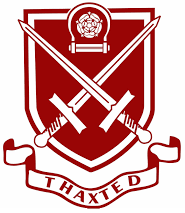Computing
Computing Curriculum at Thaxted Primary School
Computing helps children understand the digital world around them and incorporates our 6 Rs in that computing enables children to be;
- Respectful to others; apply and use Reasoning skill
- Be Resilient when solving problems
- Take Responsibility for keeping their personal information safe and know where to go for help
- To Reflect on whether all information online is reliable
- To be Resourceful in all areas of their learning and use computing knowledge to be creative.
Basic skills in using different programs such as Word, Excel, Powerpoint, art packages and coding are taught to children from reception to year 4. Once children are in years 5 and 6 we start to encourage our pupils to use their knowledge and skills to be independent and confident to choose the best tools to complete tasks and challenges set by teachers.
In Reception children will cover the following areas:
- To know how to operate simple equipment, such as CD players or remote control toys.
- To know that information can be retrieved from computers.
- To complete a simple program on a computer.
- To interact with age-appropriate computer software.
- To recognise that a range of technology is used in places such as homes and schools.
- To select and use technology for particular purposes.
In Years 1 and 2, your child will be taught to:
- Understand what algorithms are (a set of step-by-step instructions for carrying out a function), how they are used as programs on digital devices, and that programs work by following these precise instructions.
- Create and debug (find and remove errors from) simple computer programs.
- Use logical reasoning to predict the behaviour of simple programs.
- Use technology to create, organise, store, manipulate and retrieve digital content.
- Recognise common uses of information technology in the wider world.
- Use technology safely and respectfully, keeping their personal information private.
- Know where to go for help and support if they’re worried about anything they see on the internet or other online technologies.
A computing lesson in years 1 and 2 might look like the following:
- Write a set of step-by-step instructions for sharing sweets fairly among friends or build a maze out of boxes and help a blindfolded friend navigate through it by giving them precise instructions, helping them gain an understanding of algorithms.
- Program a programmable toy such as a Bee-Bot to travel around the classroom floor.
- Use a program such as Paint to create a picture.
- Use a spreadsheet program to record and store the results of a science experiment.
- Use search engines to collect information for a project with a subject like the Great Fire of London.
- Design a poster about online safety.
Computing lessons in school won't always be taught using a computer or an ipad, as learning about the principles of computer science can be done in a hands-on, screen-off way, too.
In Key Stage 2 - Years 3 to 6, children will be taught to:
- Design, write and debug programs that accomplish specific goals, including controlling or simulating physical systems.
- Solve problems by breaking them down into smaller parts.
- Use sequence, selection, and repetition in programs; work with variables and various forms of input and output.
- Use logical reasoning to explain how some simple algorithms work and to find and correct errors in algorithms and programs.
- Understand computer networks including the internet; how they can provide multiple services, such as the worldwide web; and the opportunities they offer for communication and collaboration.
- Use search technologies effectively, understand how results are selected and ranked, and be discerning in evaluating digital content.
- Select, use and combine a variety of software (including internet services) on a range of digital devices to design and create a range of programs, systems and content that accomplish specific goals, including collecting, analysing, evaluating and presenting data and information.
- Use technology safely, respectfully and responsibly; recognise acceptable and unacceptable behaviour; identify a range of ways to report concerns about content and contact.
Computing projects in Years 3 to 6 might include:
- Developing a simple computer game using a visual, interactive programming language such as Scratch.
- Creating a web page about cyber safety.
- Learning to write and edit simple algorithms using HTML.
- Setting up a class blog about what they have been learning at school.
- Using search engines to collect information about a project.
- Creating a Powerpoint presentation about something they learned on a school trip.
- Taking photos using a digital camera, transferring them to the hard drive and editing them.
- Producing digital music using an app like Isle of Tune.
For further reading and resources you can use at home please use the following links.
https://www.theschoolrun.com/primary-school-coding-explained-for-parents
https://www.theschoolrun.com/primary-school-computing-and-ict-glossary-for-parents
-
Move media down Think You Know
Guide to E-Safety and Security
